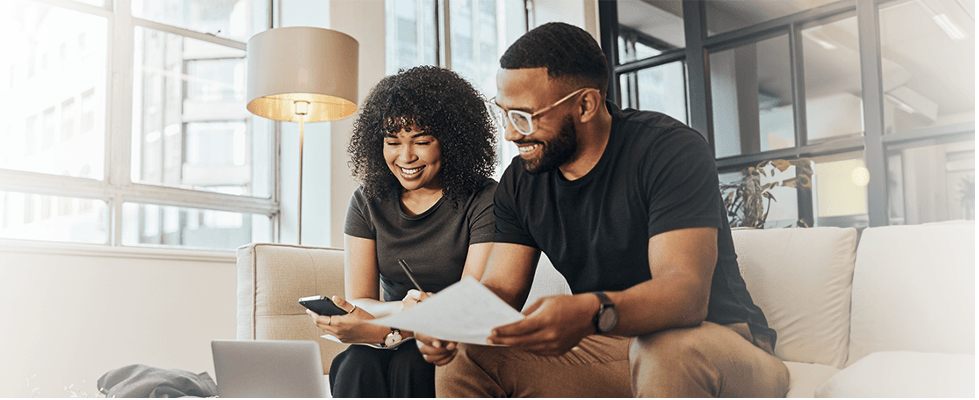How to open a bank account online

Opening a bank account online is a convenient way to manage your money without setting foot in a local branch. Today, many online-only banks, traditional banks, and credit unions have easy online applications, so you can shop around and open an account from the comfort of your home. Whether this is your first time opening an account or you need a quick refresher, here’s a step-by-step guide to opening a bank account online.
4 steps to open a bank account online
1. Decide where to open an account.
Shopping around with many banks and credit unions before opening an account can help you choose the right home for your money. So, consider putting together a list of financial institutions to compare based on customer reviews, banking app features, and available perks.
Since you work hard for your money—and want to keep it safe—looking at how each bank or credit union protects your financial information and accounts is also important.
Financial institutions have different security features to protect data. Encryption is used to hide your information, and you may be required to set up two-factor authentication to verify your identity each time you log into your account.
For example, financial institutions could ask you to set up a password and activate two-factor authentication to enter the mobile banking app. When logging in on a non-mobile device, you may need to put in a password and answer security questions. These security measures are in place to make it more difficult for unauthorized people to gain access to your money.
Know how your money is kept safe
FDIC and NCUA insurance are government guarantees that protect up to a combined $250,000 in bank accounts at banks or credit unions, respectively. In the event a financial institution closes, these guarantees ensure you’ll be able to retrieve your money. Most banks have FDIC insurance and most credit unions have NCUA insurance, but it’s worth double-checking before opening an account.
Financial institutions also provide protection in the event you lose your debit card. If someone gains access to your PIN or the card itself is lost or stolen and you report the loss within two business days, you’re typically only liable for up to $50 in fraudulent charges. You’ll be able to report the loss quickly by setting up alerts that notify you when your card is being used—even if you hadn’t yet noticed your card was missing.
Even if you haven’t lost your card but you notice unauthorized charges on your periodic account statement, you’ll have 60 days (from the date you receive your statement) to report it, which is why it’s important to always review your statements when you receive them. Reporting after two months could make you responsible for more of the fraudulent charges.
2. Choose an account type.
After choosing a financial institution, the second step is choosing the type(s) of account you need. Four main types of bank accounts exist—checking accounts, savings accounts, money market accounts, and certificates of deposit. Here’s an overview of each.
Checking accounts
Checking accounts are deposit accounts you can use for day-to-day transactions. They typically come with a debit card to make purchases or withdraw money at ATMs. Some accounts come with paper checks, or you can order them. You can also use checking accounts to deposit checks, direct deposit your paycheck, make wire transfers, and more.
Traditionally, checking accounts have paid little or nothing in interest. However, some high-yield checking accounts offer a higher-than-average return.
Other factors to review when shopping for a checking account are the monthly maintenance fees, ATM fees, the minimum deposit to open the account, and the minimum balance you must maintain to keep the account open.
Savings accounts
Savings accounts are a place to stash money for emergencies or financial goals, such as new furniture or a vacation. Savings accounts typically offer higher APYs than checking accounts. However, high-yield savings accounts may offer a better return.
Unlike checking accounts, savings accounts do not typically come with checks or a debit card. Some banks and credit unions may charge a fee if you have more than a certain number of withdrawals from your savings account in a month.
Money market accounts
Money market accounts are like a checking and savings account hybrid. APYs for money market accounts can be comparable to those of savings accounts, and they may also limit how many transactions you can make per month. But like a checking account, money market accounts may come with a debit card and checks, giving you more payment options.
Certificate of deposit (CD) accounts
A CD is a deposit account that offers a fixed rate of return over a specified term. When the CD matures, you get the money you initially deposited plus interest, and you can withdraw funds or roll the CD into another term.
Terms for CDs generally range from a few months to five years or more. In general, the longer your loan term, the higher the APY you can earn. However, withdrawing from the CD early can result in fees or forfeiting a few months’ interest. Also, if interest rates on savings products rise due to inflation, you could be stuck with low interest until the CD matures. (In that case, paying a fee or penalty to unlock the money may be worth it.)
3. Fill out the online application.
The process of opening the account involves filling out an online form and choosing an account authentication method, such as security questions to answer upon login. Here’s the information you could be asked to provide when opening an account:
Name and physical address
Phone number and email address
Date of birth
Social Security number or taxpayer identification number
To process your application, banks may review your checking and savings account history using information obtained from a credit reporting agency. Your credit report can include information such as where you’ve opened bank accounts, and if you have any returned checks, unpaid balances, or fraudulent activity on past accounts.
Some banks may deny your application if you have an unfavorable banking history, such as a record of overdrafts or unpaid balances. However, an unfavorable banking history doesn’t mean you can’t get a checking account. Paying down unpaid bank overdrafts could help improve your chances of getting an account. You can also search online for second-chance banking options that are easier to qualify for. If you’re not sure what information is on your banking history record, you’re entitled to review your credit report annually for free.
4. Add money to your account.
Now you’re in the home stretch—time to fund your account. The online application process usually includes a step where you can connect an external account to transfer funds to your new account. During the connection process, the new bank may make small deposits—and withdrawals—of a few cents in your existing bank account to verify that it is correct. You’ll then contact the new bank with the exact amounts to confirm.
If you don’t set up the first deposit into your new checking account during the application, you could fund your account later through other methods, like setting up a direct deposit with your employer, depositing cash at a branch and ATM, or depositing checks or money orders using mobile check deposit.
How to open a bank account for a minor online
You typically need to be at least 18 to apply for a bank account. You can open an account on behalf of a minor, but that process requires different paperwork and may require permission from the child’s parent or legal guardian.
Depending on the purpose of the account, consider whether the bank is the best place for it. Savings accounts can help teach children to save, and teens may benefit from learning to manage a checking account.
How long does it take to open an account?
It could take just a few minutes to open a bank account online, particularly if you already have a relationship with the financial institution. However, it might take several days if the bank needs more information from you. For example, if the bank can’t verify your identity, you may be asked for other documentation before the account can be set up.
The bottom line
Most banks offer online applications, so you have many options to consider. Even if you’re already a customer at one bank, expanding your options to look at what other banks offer might help you find higher APYs, lower fees, or better perks.
Before shopping around, consider how much money you have available to deposit and how often you will want access to it. Also, check if there are conditions you must meet to avoid monthly fees. While some online bank accounts have no fees, others might charge you a fee if you don’t meet direct deposit or balance requirements each month.
Fees are not the whole story, though. If you plan to use a smartphone to conduct your banking business, you’ll want to check that the bank has an easy-to-use mobile app and find out how responsive customer service is in case you need to call in for support.




